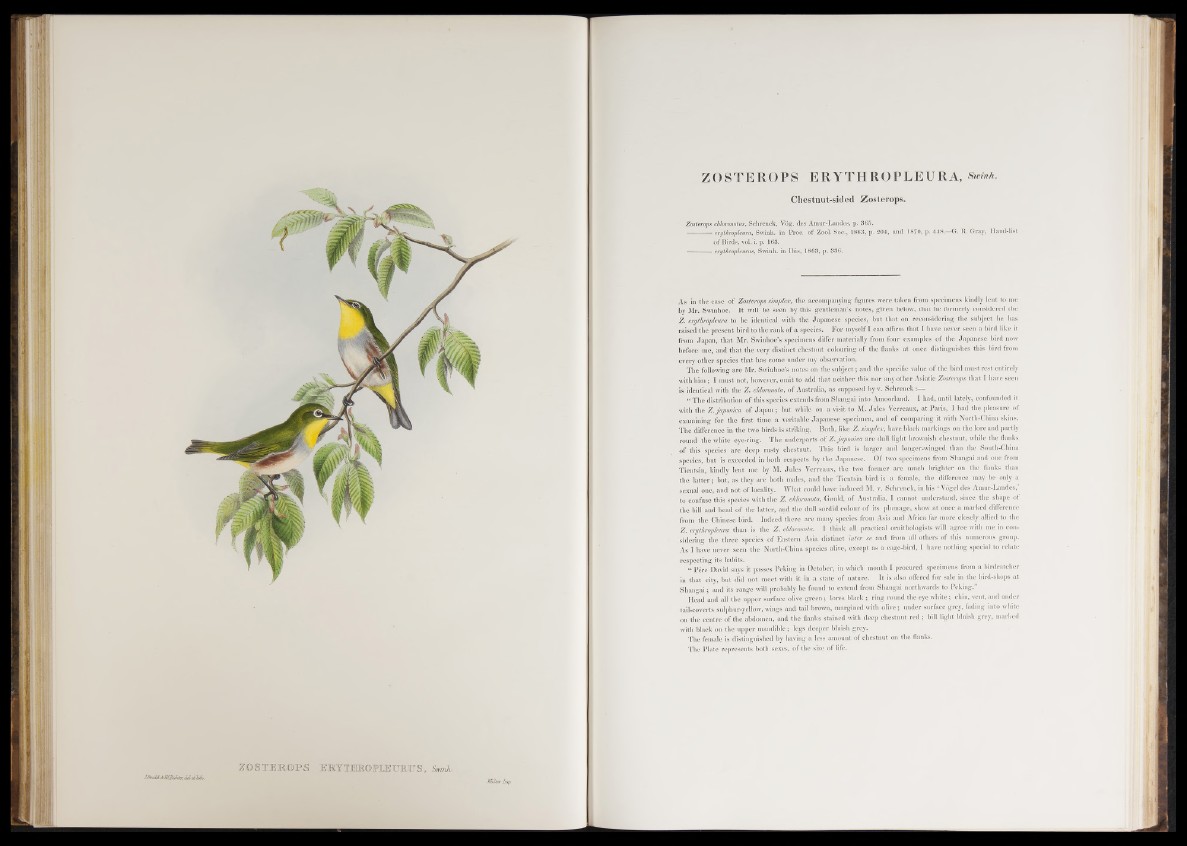
ZO ST ER O P S ERYlHROPrEtrKtrS, Smth.
J.&iuULiÆRickto; d&dïbJhi.
Z O S T E R O P S E R Y T H R O P L E U R A , Swinh.
Chestnut-sided Zosterops.
Zoster ops chloronotus, Schrenck, Vög. des Amur-Landes, p. 365.
-----------erythropleura, Swinh. in Proc. of Zool. S e e ., 1863, p. 204, and 1870, p. 448.—G. R. Gray, Hand-list
of Birds, vol. i. p. 163.
-—■—— erythropleurus, Swinh. in Ibis, 1863, p. 336.
As in the case of Zoslerops simplex, the accompanying figures were taken from specimens kindly lent to me
by Mr. Swinhoe. It will be seen by this gentleman’s notes, given below, that he formerly considered the
Z. erythropleura to be identical with the Japanese species, but that on reconsidering the subject he has
raised the present bird to the rauk of a species. For myself I can affirm that I have never seen a bird like it
from Japan, that Mr. Swinhoe’s specimens differ materially from four examples of the Japanese bird now
before me, and that the very distinct chestnut colouring of the flanks at once distinguishes this bird from
every other species that has come under my observation.
The following are Mr. Swinhoe’s notes on the subject; and the specific value of the bird must rest entirely
with him ; I must not, however, omit to add that neither this nor any other Asiatic Zosterops that I have seen
is ideutieal with the Z. chloronota, of Australia, as supposed by v. Schrenck :—
“ The distribution of this species extends from Shangai into Amoorland. I had, until lately, confounded it
with thé Z. japónica of Japan ; but while on a visit to M. Jules Verreaux, a t Paris, I had the pleasure of
examining for the first time a veritable Japanese specimen, and of comparing it with North-China skins.
The difference in the two birds is striking. Both, like Z. simplex, have black markings on the lore and partly
round the white eye-ring. The underparts of Z. japónica are clfiil light brownish chestnut, while the flanks,
of this species are deep rusty chestnut. This bird is larger and longer-winged, than the South-China
species, but is exceeded in both respects by the Japanese. Of two specimens from Shangai and one from
Tientsin, kindly lent me by M. Jules Verreaux, the two former are much brighter on the flanks than
the latter; but, as they are both males, and the Tientsin bird is a female, the difference may be only a
sexual one, and not of locality. What could have induced M. v. Schrenck, in his ‘ Vôgel des Amur-Landes,’
to confuse this species with the Z. chloronota, Gould, of Australia, I cannot understand, since the shape of
the bill and head of the latter, and the dull sordid colour of its plumage, show at once a marked difference
from the Chinese bird. Indeed there are many species from Asia and Africa far more closely allied to the
Z. erythropleura than is the Z. chloronota. I think all practical ornithologists will agree with me in considering
the three species o f Eastern Asia distinct inter se and from all others of this numerous group.
As I have never seen the North-China species alive, except as a cage-bird, I have nothing special to relate
respecting its habits.
“ Père David says it passes Peking in October, in which month I procured specimens from a birdcatcher
in that city, but did not meet with it in a state Of nature. I t is also offered for sale in the bird-shops at
Shangai ; and its range will probably be found to extend from Shangai northwards to Peking.”
Head and all the upper surface olive green ; lores black ; ring round the eye white ; chin, vent, and under
tail-coverts sulphur-yellow, wings and tail brown, margined with olive ; under surface grey, fading into white
on the centre of the abdomen, and the flanks stained with deep chestnut red ; bill light bluish grey, marked
with black on the upper mandible ; legs deeper bluish grey.
The female is distinguished by having a less amount of chestnut on the flanks.
The Plate represents both sexes, of the size of life.